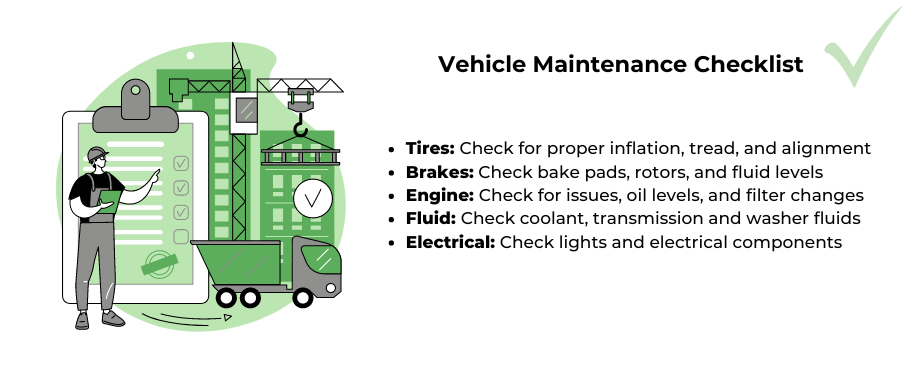The Ultimate Fleet Safety Guide For Fleet Managers

Fleet safety is more than just a topic in the transportation industry—it’s a critical component that can make or break a company’s operations. For fleet managers, ensuring the safety of drivers and vehicles is paramount.
With countless vehicles on the road daily, managing these fleets effectively is a substantial responsibility. This guide aims to provide fleet managers with comprehensive insights into optimizing fleet operations. From road safety to implementing best practices and using technology, this post covers everything you need to know to keep your fleet safe and sound.
- Understanding the Risks
- Best Practices for Fleet Safety
- Roadway Safety Tips
- Vehicle Maintenance Guide
- Measuring and Improving Safety Performance
Understanding the Risks
Driving for work involves a myriad of risks that fleet managers must be aware of. Accidents are, unfortunately, a common occurrence, often resulting in significant financial loss and potential harm to drivers. Fatigue is another critical risk, as long hours on the road can lead to decreased reaction times and poor decision-making. Additionally, vehicle maintenance issues, if left unchecked, can cause unexpected breakdowns and accidents. Understanding these risks is the first step in mitigating them.
Accidents on the Road
Work-related driving accidents can be costly and dangerous. The National Highway Traffic Safety Administration (NHTSA) reports that vehicle crashes cost employers $60 billion annually in medical care, legal expenses, property damage, and lost productivity. Fleet managers must recognize the factors that contribute to accidents, such as distracted driving, speeding, and failure to follow traffic laws.
The Problem of Fatigue
Driver fatigue is a serious issue that can impair judgment and slow reaction times. According to the 2023 National Sleep Foundation Report, fatigued drivers are involved in an estimated 300,000 crashes each year, resulting in 6,400 deaths and 100,000 injuries. Encouraging regular breaks and monitoring drivers’ hours can help reduce the risk of fatigue-related accidents.
Vehicle Maintenance Issues
Regular vehicle maintenance is crucial for preventing breakdowns and accidents. Issues like worn-out tires, brake failures, and engine problems can lead to dangerous situations on the road. Fleet managers must ensure that all vehicles are regularly inspected and maintained to keep them in optimal condition.
Best Practices for Fleet Safety
Implementing a comprehensive fleet safety program is essential for minimizing risks. This involves driver training, adhering to vehicle maintenance schedules, and leveraging safety technology. These best practices can significantly enhance overall fleet safety.
Comprehensive Driver Training
Driver training programs should cover essential safety topics, including defensive driving, proper vehicle operation, and emergency response. Training should be ongoing, with periodic refreshers to ensure that drivers remain updated on the latest safety protocols.
Regular Vehicle Maintenance
Creating a strict maintenance schedule helps prevent vehicle-related accidents. Regular inspections should cover tire checks, brake inspections, engine diagnostics, and fluid level checks. Maintaining detailed records of all maintenance activities ensures that no aspect of vehicle care is overlooked.
Leveraging Safety Technology
Modern safety technologies can greatly assist in reducing accidents and monitoring driver behavior. Tools like telematics systems provide real-time data on vehicle location, speed, and driver performance. Dashcams can capture incidents and provide valuable insights for future training.
Roadway Safety Tips
Reducing the risk of accidents requires specific on-road strategies. Defensive driving, understanding inclement weather conditions, and sharing the road with other vehicles are critical components of roadway safety.
Defensive Driving Techniques
Defensive driving involves anticipating potential hazards and being prepared to react safely. Fleet managers should encourage drivers to maintain a safe following distance, avoid aggressive driving, and stay alert to their surroundings.
Dealing with Inclement Weather
Weather conditions can dramatically affect driving safety. Drivers should be trained to handle various weather scenarios, such as rain, snow, and fog. Techniques like reducing speed, using headlights correctly, and maintaining a safe distance from other vehicles are essential for navigating adverse conditions.
Sharing the Road
Fleet drivers must be mindful of other road users, including pedestrians, cyclists, and motorcyclists. Educating drivers on the importance of yielding the right of way, checking blind spots, and using turn signals can help prevent collisions and ensure the safety of all road users.
Vehicle Maintenance Guide
Regular vehicle maintenance is critical for ensuring the safety and longevity of fleet vehicles. A well-maintained fleet reduces the risk of accidents, improves fuel efficiency, and lowers overall operational costs.
Importance of Regular Maintenance
Preventative maintenance can identify potential issues before they become major problems. Regularly scheduled maintenance can extend the lifespan of fleet vehicles and ensure they operate safely and efficiently.
Maintenance Checklist
A thorough maintenance checklist should include:
Tire Inspections: Check for proper inflation, tread wear, and alignment.
Brake Checks: Ensure brake pads, rotors, and fluid levels are in good condition.
Engine Diagnostics: Regularly check for any engine issues, including oil levels and filter changes.
Fluid Levels: Monitor and maintain coolant, transmission fluid, and windshield washer fluid levels.
Lighting and Electrical Systems: Ensure all lights and electrical components are functioning correctly.
Keeping Detailed Records
Maintaining detailed records of all maintenance activities helps track the history of each vehicle and ensures that no aspect of care is overlooked. These records can also be valuable for identifying recurring issues and planning future maintenance needs.
Measuring and Improving Safety Performance
Continuous improvement in fleet safety requires measuring performance and using data to drive enhancements. Key performance indicators (KPIs) and data analysis are vital tools for improving safety outcomes.
What Metrics Determine Fleet Safety Performance?
KPIs for fleet safety include metrics such as accident rates, driver behavior, and vehicle downtime. Monitoring these indicators helps fleet managers identify trends and areas for improvement.
Strategies for Continuous Improvement
Implementing strategies for continuous improvement involves regularly reviewing safety data, providing ongoing training, and updating safety protocols as needed. Encouraging feedback from drivers can also provide valuable insights for enhancing safety measures.
Data Analysis for Safety Enhancement
Using data analysis tools can help identify patterns and trends in fleet safety. Analyzing data from telematics systems, maintenance records, and driver reports can reveal areas where additional training or changes in procedures may be needed.
Conclusion
Fleet safety is a critical responsibility for fleet managers. By understanding the risks associated with work driving, implementing best practices, and leveraging technology, fleet managers can significantly enhance the safety and efficiency of their operations. Regular vehicle maintenance, defensive driving techniques, and continuous performance measurement are key components of a successful fleet safety program.
Remember, a safe fleet is not only about protecting assets but also about ensuring the well-being of drivers and the public. As you move forward in your role, continue to prioritize safety and seek out resources and training to stay informed about the latest advancements in fleet safety. Contact us today to see how Safety Reports can help enhance your safety program.




